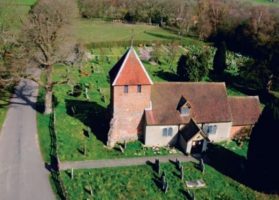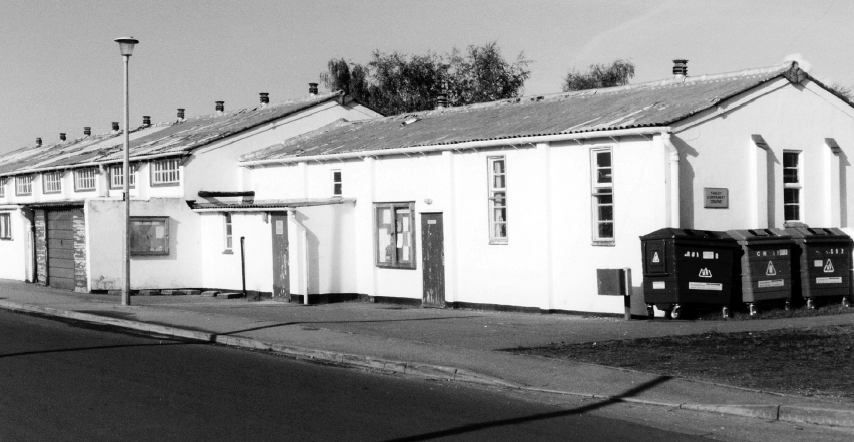Although far fewer lives were lost, World War II had a far greater impact on the lives of Tadley residents and the locality than did World War I. Initially Tadley experienced a relatively quiet war. It suffered the annoyances of the black-out, carrying gas masks and rationing but the absence of military sites meant residents saw only limited enemy action and heard few or no air-raid sirens.
The Aldermaston airfield was opened by No 92 Group of the RAF on 1 July 1942 but it was never used by the Wellington bombers as intended because by then it had been reallocated to the United States Army Air Force (USAAF), becoming station No 467 on 20 October of that year. Many of the aircraft that left for France on the morning of D-Day, 6 June 1944, flew from Aldermaston. From the moment the American servicemen arrived in Tadley, the village became a fervour of activity, both on the ground and in the air.
Initially, the southern edge of the airfield corresponded with the position of the present Atomic Weapons Establishment perimeter fence, but as the war continued and D-Day approached, the airfield grew and encroached more and more upon the village. Sentry boxes were located at various points around the site and people living within the restricted zone were issued with passes and visitors were escorted by the Military Police.
Outside the perimeter of the airfield, and not part of Station 467, was Hangar 5, built in addition to the other four. In July 1943 it was taken over by the Ministry of Aircraft Production (MAP) for the assembly of Spitfire aircraft. The Spitfire was initially produced at the Supermarine factory in Southampton but, after heavy bombing of the works, it became necessary to move production to a number of smaller sites throughout the south of England, one of which was at Reading. Final assembly and testing took place at Aldermaston and Henley Aerodromes.
Throughout 1942 the scattered dwellings of north Tadley were gradually swallowed-up by the 17 military sites built to accommodate and cater for American service personnel; approximately 300 buildings of various type and size. These were scattered over an area stretching from New Road in the south to the A340 in the north, and Blakes Lane in the east to Bishopswood Lane in the west. In the days prior to D-Day a ‘Tent City’ was also erected to accommodate those additional airmen coming to the airfield en-route to France.
Unlike World War I, this war would become a highly mechanised one and the need for funds to finance this and to feed the nation was to be a daily challenge. This is shown through the numerous advertisements, articles and reports on the pages of the Hants & Berks Gazette between 1939 and 1945, many of which have been included in the following text.
An oral history project completed in 1999 gives us a first-hand account of the lives of residents in the adjoining village of Pamber Heath (PH) during World War II and some of this has also been included, together with the memories of three Tadley (T) residents.
Many similarities can be seen between life in Tadley in 1914-18 and that of 1939-45, but likewise many differences, the biggest being the influence and impact of the Americans on village life.
Children and schooling
Brian Gooch’s (T) childhood memories are filled with the war. It intruded into school life in many ways. At assemblies the headmaster, Mr Miller, read out letters from ex-pupils serving in the Armed Forces. Air-raid practices were held twice weekly when pupils would spend 20 minutes away from the classroom, a great excuse for fun! There were five or six shelters (long since demolished) at the back of the school. Gas masks were also checked at school, no doubt more lesson time lost ! In other ways school carried on much as before with the Attendance Officer calling regularly and examinations being taken.
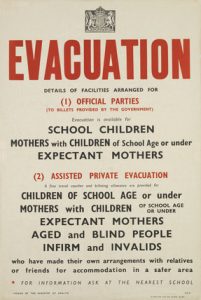
The evacuation of civilians in Britain during the World War II was designed to protect people, especially children, from the risks associated with aerial bombing of cities by moving them to areas thought to be less at risk. Operation Pied Piper, which began on 1 September 1939, officially relocated more than 3.5 million people. There were further waves of official evacuation and re-evacuation from the south and east coasts in June 1940, when a seaborne invasion was expected, and from affected cities after the Blitz began in September 1940.
The arrival of evacuees in Tadley School saw the pupil numbers swell some weeks by as much as 25%. By June 1941 the Borough had taken in 1,245 evacuees and refugees. Some soon moved away, others remained for longer. Often they were relatives of Tadley families while other evacuees, Brian Gooch recalls, ‘might have come from another planet’, so unfamiliar were Tadley children with life and people outside their village.
Children were encouraged to help with raising funds for the war effort. The Hants & Berks Gazette reported in October 1941 that Tadley Council School had, over two years, raised enough to pay for a ‘heavy machine gun and bomb’! A December 1942 report says they sent £5 1s 8d to the Red Cross and St John’s fund.
Their help was also invaluable in the collection of salvage. The shortage of petrol would have made the collection of salvage in rural areas like Tadley a problem. Children were able to channel the smaller, lighter items such as paper, to central collection points.
The presence of Americans in their village was hugely exciting for the children. Sweets, strictly rationed in July 1942, and chewing gum were given out in abundance, comics distributed and parties organised for them in the local village halls when unheard of treats like ice cream and Coca Cola were served. Initially, access to the airfield was allowed and the American servicemen would show Tadley children over their planes. Those children living in the north of the village were at a distinct advantage when it came to treats as they were within the secure zone and saw much more of the servicemen. Margaret Kersley (nee James) lived within the security zone in Franklin Avenue (then East Street). She does not recall that playing out with friends was ever a problem, ‘I do not think we were ever asked for our security pass’.
Civil Defence
This was mainly the responsibility of two groups: Air Raid Precautions (ARP) and Local Defence Volunteers (LDV).
Little reference can be found to the former on a local level. However, the 1939 Register records those who had already volunteered as ARP wardens, in total 13, including three women. It lists Henry Howard aged 62, a retired bank manager, as Chief Warden for Tadley. Dates and venues for gas masks to be safety checked appear in the Hants & Berks Gazette, sometimes in private homes, other times in village or church halls. The paper also reports at length the concerns of the Hampshire education authority on the lack of sufficient air raid shelters in schools and the many ARP exercises that took place.
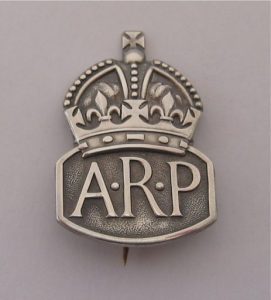
Air Raid Precautions (ARP) cap badge.
The Local Defence Volunteers, re-named the Home Guard by Winston Churchill in July 1940, was the civilian defence group. Forever enshrined in the television series Dad’s Army, the LDV was formed in May 1940 to counter the perceived threat of invasion, particularly by German parachutists. Civilian men between the ages of seventeen and sixty-five were encouraged to join. As a result most towns and villages, including Tadley, had their own platoons. For the most part their work involved the manning of look-outs and patrolling. In the event of enemy sightings they were to attack swiftly or to observe and report. Hence their nickname the ‘Look, Duck and Vanish’ brigade. Failure to attend for duty or failure to carry it out resulted in a fine.
A warning was issued in May 1940, reminding the public that the LDV was a military force and as such they were expected to co-operate with them in every way. In 1941 the organisation and control of the Home Guard was taken over by the Army.
Tadley Home Guard Platoon (and Baughurst) was part of the Kingsclere Company which in turn belonged to the 2nd Hampshire Whitchurch Battalion. Tadley Home Guard participated with Pamber and Silchester (3rd Basingstoke Battalion) in training exercises and Tadley invited Baughurst Home Guard to their meetings and probably vice-versa.
John (PH) recalls his father, a member of the Home Guard, making small explosive bombs on the kitchen table!
By the end of 1944 any prospect of a German invasion had long since passed and the Home Guard was disbanded; each man was awarded a certificate signed by the King.
Communication
In September 1939 the Hants & Berks Gazette displayed an advertisement for the latest Marconi portable radio priced 8 guineas, available from Giffords of Winchester Street. This would have been a considerable outlay in times of such austerity and a rented wireless or a home-made crystal set was probably more common. The former were usually powered by an accumulator which would have to be charged-up at a local garage or bicycle shop approximately every two weeks, depending on its usage; 6d a charge. This meant that information pertaining to the war, that in World War I had been lacking, would become part of everyday life.
The wireless provided much needed entertainment such as Workers Playtime; ITMA and dance band music. Cookery programmes were broadcast, offering recipes designed to make meagre rations and war-time foods more palatable. One such, Kitchen Front was on the air daily at 8:15 am.
A limited telephone service to a few Tadley residents had opened in 1923. It was run by the mother and sister of George Warren (no. 27), one of the men named on the Tadley War Memorial. Having a line of communication undoubtedly proved invaluable to the Civil Defence wardens during the war.
Enemy Action
Following the evacuation of Dunkirk in May and June 1940, the threat of invasion was considered likely and instructions on public safety were published in the Hants & Berks Gazette and on the wireless.
As of June the ringing of church bells was banned. They were only to be used for home defence in the event of an air-borne attack.
Children were encouraged to enter competitions to recognise enemy aircraft whereby they could win a prize!
Securing one’s home was essential in the event of an air-borne attack and even Tadley residents, away from most of the bombing, still had to conform to regulations, such as the black-out or face prosecution and fines. A refuge room in the house or a shelter was recommended and most common was the Anderson Shelter; a prefabricated corrugated-steel structure designed for ‘do it yourself’ erection in a specially dug hole in the garden. It was meant to accommodate between four and six people. Many people preferred not to use it as it was damp, cold and very cramped.
The few shelters that remain in Tadley are not Anderson shelters. It is believed they are more likely to be blast shelters, a much more substantial concrete type of shelter that is referred to on the military airfield Dispersed Sites map. Each military site marked in the village had an air raid or blast shelter, some both.
Margaret Kersley (neé James) recalled the Morrison Shelter in their sitting room in Franklin Avenue (then East Street). It was another type of shelter, made of steel with mesh sides, which was introduced in 1941. It was designed to sleep two adults and one child and doubled as a table. She slept there many nights when they had evacuees to stay.
Even before the completion of Aldermaston airfield German bombers could be seen flying over the area most nights and as a consequence a Searchlight Station was placed at Causeway Farm near ‘The Wellington’ public house, Baughurst.
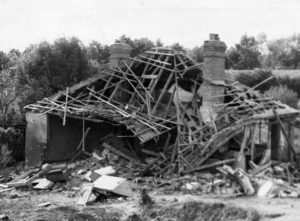
The ruins of Andrew Broadhurst’s house and shop in The Glen, Pamber Heath after it was struck by a bomb on Monday 16 September 1940.
On the night of 2 July 1940 four bombs were dropped near Rawlins Farm, Monk Sherborne. Another fell in Sherborne Wood and several small incendiary devices started small fires near Rookery Dell. In September 1940 three German bombs were dropped in Pamber Heath tragically killing Rose Long and her aunt Winifred, with others suffering minor injuries. Several bombs fell in Baughurst, with one fatality. All, it could be assumed, related to aircraft which were lost or just wanting to ditch their remaining bombs before returning home.
Bramley Central Ammunition Depot, founded in 1917, was a top secret ammunition store only five or six miles from Tadley. Fire watching crews were established on high points around the depot to warn of possible enemy raids. Thankfully the depot survived any major enemy action.
Air-raid warnings gradually became more commonplace, so much so that children, so used to the siren sounding with nothing happening, continued playing. The GIs were very nervous and would jump into the nearest ditch. A diary of a USAAF airman records hearing his first siren on 8 August 1942, the day after his unit arrived at the airfield. It was at 17:45 and lasted 15 minutes before the all clear sounded. This was to be the first of many he recorded.
Food & Agriculture
As in World War I, Tadley families were fortunate to still have large gardens and allotments from which to feed themselves. However, this time with a difference. Drawing on the experience of World War I, within a month of the declaration of war, the Government proclaimed that the humble allotment would be the possible saviour of the country. The ‘Dig for Victory’ campaign had begun. The Ministry of Food strictly controlled the use of land for growing produce. The sale of surplus eggs and animals for slaughter was restricted to the ministry. However, within this was a system of egg collection for local hospitals. In the spring of 1941 Heath End & Baughurst collected 463 surplus eggs which were delivered to the Royal Berkshire Hospital. Probably one of many such deliveries. Rationing limited eggs to one per person per week but Arthur (PH) tells of eggs being plentiful and of how men and lads would ferret in farmers fields and carry home a dozen or more dead rabbits on a pole which would be sold around the village. The farmer was pleased to have the vermin kept down and villagers grateful for a rabbit stew or pie.
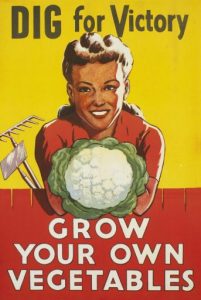
Posters, such as the ‘Grow your own vegetables’ one shown here, were part of a massive propaganda campaign aiming both to ensure that people had enough to eat, and that morale was kept high.
Elizabeth (PH) remembered pies being available through a scheme at the village hall. A Rural Pie Scheme was launched in 1942 and organised by the Women’s Voluntary Service (WVS). At its peak an average of one and a quarter million pies were being distributed to some five thousand villages. The Hants & Berks Gazette reported on 16 July 1943 that Kingsclere and Whitchurch Rural District, to which Tadley belonged, had sold 49,928 pies between January – June 1943 providing a profit of £72 15s 10d for the Ministry of Food. In addition, the WVS took pies and other snacks to agricultural workers in the fields. The PH study indicates that rationing did not affect the village too much. Most cottages had vegetables and fruit in the garden and there were always plenty of blackberries, hips and other wayside produce. Nancy (PH) said ‘you just had to be careful’.
The Hants & Berks Gazette printed large weekly posters, issued by the Ministry of Food, designed to encourage the housewife to be imaginative with her supplies: Pastry – use two-thirds flour with one-third potato’; ‘Serve ‘Fadge’ and ‘Floddies’ (basically potato cakes) for breakfast’; and ‘Remember, tinned fruit needs no sugar’.
Undoubtedly the farmland in and around Tadley was used to its maximum capacity but slogans abounded to remind farmers how vital their job was in feeding the nation, for example: ‘Plough now by day and night. Play your part in the fight for right’ and ‘Ploughing on farms is as vital as arms’.
Wastage was reported and liable for a fine. In May 1943 W B of Tadley, was fined £2 for wasting 10 sacks of oats, in breach of the ‘Waste of Agricultural foodstuffs’ order.
Fund raising
There was a need by those not enduring the nightly bombing raids to feel they were ‘doing their bit’. The local response to constant demands, week upon week, by national fund raising organisations was admirable. To quote just a few: Aid to Russia Week, Warship Week, War Weapons Week, Weapons for Victory, Wings for Victory and Salute the Soldier. In January 1941 Tadley donated £43 13s 6d to the Spitfire Fund, an amount which Lady Portal, chairman of Kingsclere and Whitchurch Rural District Council, described as ‘an excellent effort’.
Alongside these were the many causes on the Home Front, which also needed support eg Cancer Relief, The Royal Berkshire Hospital, The Nursing Association and of course the annual Poppy Day collection for which, in 1940, Tadley raised £128 18s 1d.
In addition there was the Government appeal for people to buy bonds, savings stamps, certificates, and to pay into the savings scheme.
Salvage drives carried catchy slogans like : ‘Every scrap shortens the scrap’. Anything and everything seemed recyclable: metal, paper, bones, rubber, torches, rags, rope and twine, and binoculars, which were urgently needed by the armed forces.
In times of such hardship, especially for a small rural community such as Tadley, it is difficult to imagine where all this money came from.
Housing
In 1939 the same small cottages, as in 1914, still housed large families but now alongside these were a few ‘council houses’, very different in style to the old Tadley properties and with modern facilities. A succession of Housing Acts after World War I led to the creation of Council estates throughout the country. Tadley Parish Council minutes for 1919 record a proposal for ‘six Council cottages’ and in 1926 ‘twenty Council houses’. However, in 1927 the village still had only four, with six more built in 1931, and a further four by 1935; a total of only 14. Examples of these can be seen along the A340 at Mulfords Hill, opposite the Salvation Army hall, and on Main Road.
Mains services had still not been connected to Tadley homes at the start of World War II. Although the parish minutes record a few wealthy property owners going to great lengths to have electricity connected to their houses, most families continued as they had in World War I: collecting water from the well, cooking on a range heated mostly with wood, washing their clothes by hand, keeping warm in front of an open fire, and lighting their cottages with paraffin lamps and candles. By 1942 coal was in short supply, especially in the south, due to the shortage of man-power to extract it. This was resolved with the use of conscripted men, later known as the Bevin Boys. While fuel for Tadley fires would not have been a problem, with the abundance of local woodland, paper to light them may well have been. The Hants & Berks Gazette included a lengthy article in March 1941 on ‘How to light a fire without paper’! Norway was Britain’s main source of wood pulp for paper. The fall of Norway to the German invasion in 1940 led to a new national salvage drive, to collect more waste paper as quantities had fallen drastically. ‘Paper is a precious munition of war – it must not go up in smoke’. ‘Without paper there will be no cartridge cases and fewer shells’.
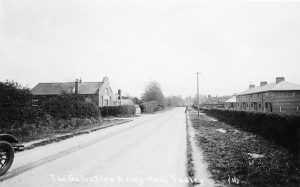
A view looking south down Mulfords Hill. Some of Tadley’s earliest council houses are on the right, opposite the Salvation Army Hall.
Householders were also encouraged to re-use coal cinders to release more coal for the ports, trains, factories.
Cesspits and soak-aways were still common and remained so until the wholesale expansion of Tadley by the Ministry of Defence in the 1950s.
The erection of the seventeen Dispersed Sites, built to accommodate the USAAF airmen, necessitated sewage disposal from the many latrines throughout the village. Two sewage disposal sites, one located in Bishopswood Lane and just south of Blake’s Lane, were built for this purpose.
Men
Conscription saw men young and old once again leaving their villages to serve their country. Reserved occupations included such trades, surprisingly, as hairdressing, deemed necessary to boost the moral at home! Local men too old or unfit for active service would be expected to do war work.
Arthur L (PH) was employed at Hangar 5 in Tadley, assembling Spitfires from the parts that arrived from the many storage depots throughout the area, eg the Venture Bus Company depot (Lattice House) in Baughurst.
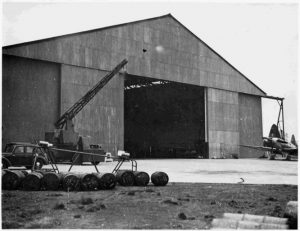
The final assembly of Spitfire Mark VIIIs in Hanger 5 in 1944.
Unlike World War I, the need for blacksmiths had now dwindled and so Herbert Attwood, previously blacksmith at Baughurst, became a postman.
The black-out restrictions saw the closure of both the Ramsdell and the Tadley brick kilns, the latter never to re-open. The workers were redeployed or went to war.
Although Greenwoods of London were the main contractors for the building of the airfield at Aldermaston in 1941, they employed much local labour.
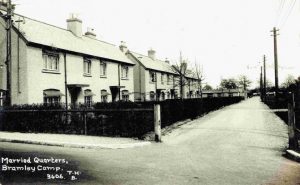
Bramley Ordnance Depot, later known as Bramley Central Ammunition Depot, opened in 1917 for the manufacture and storage of ammunition. To enable both safe manufacture and storage of munitions, well spaced railway tracks were built both sides of the Great Western Railway line connecting Basingstoke and Reading
The 1939 Register shows that a great many Tadley men were employed at the Bramley Central Ammunition Depot. During World War II there was an enormous expansion of the camp; by 1944 the total military and civilian staff had reached approximately 4,400 and the depot handled an average of 35,000 tons of ammunition a month.
Rationing
In 1939 around 60% of British food was imported. This included even basics like onions coming from the Channel Islands. Imported foodstuffs became the target of enemy U-boats once again. The need to ration that which did get through and to increase home grown supplies was paramount. Government planning put systems in place to ensure that rich, poor, young and old all shared what resources were available. Rationing began on Monday 15 January 1940, at first with bacon, sugar and butter, later for meat and margarine. The system soon applied to clothing (June 1941), household items and soap (1942). In Tadley, throughout most of the war, ration books were usable at Tom Marks, butcher and Yorke Lowe Supply Stores at Mulfords Hill (the forerunner of Budgens and later Sainsbury’s supermarket).
By the end of 1940, Canada was the major supplier of a great many foodstuffs to Britain, particularly tinned foods such as salmon, tomatoes, fruit and condensed milk. A year later other Commonwealth countries were also supplying tinned food, 30,000 tons in total. From November 1941, the housewife could ‘purchase’ such goods using the new ‘Points’ coupon book. This was a modified version of the Ration book. It allowed for self selection amongst a range of goods as opposed to the stipulated allowances dictated by the Ministry of Food.
Food rationing did not finally end until 3 July 1954.
Social Life
Social activities became very important, not just as a relief from thoughts of war, but as a means of raising much needed funds for the war effort. Entertainment was also provided for the wounded from Park Prewett hospital and for evacuees. Freda (PH) recalls playing the piano for such events. The Hampshire Garden Scheme saw local big houses such as Pinnocks (now The Grange) in Tadley and Silchester Hall open their gates to visitors on summer days. Admission charges raised funds for national and local causes. In June 1941 the annual ‘Maying’ event took place at the Fighting Cocks where ‘a spacious bower was erected by Mr John Saunders for dancing’. If people were able to travel to Basingstoke they could see, amongst others, the long awaited film Gone with the Wind showing in November 1942.
Young lads not yet called up re-formed depleted football and cricket teams. The Tadley band saw 16 of its members go to war, with sadly two never to return; one of these being Stanley Bowman (no. 33), named on the Tadley War Memorial. Remaining band members trained new young players and carried out a few engagements, one of which was to provide the music for Sunday evening service at building 223, the USAAF Chapel and Gymnasium. This later became the Community Centre, Newchurch Road.
Unnecessary train journeys were discouraged in order to release the railways for essential war related transport and a ‘holidays at home’ campaign, together with no doubt, a lack of funds, meant people stayed close to home.
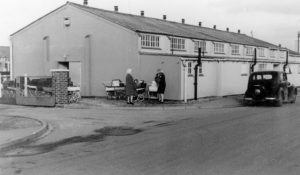
The Old Community Centre, Newchurch Road was originally the Aldermaston Airfield gymnasium and chapel (Building 223). It later served as a hostel for the employees of A E Chivers & Sons Ltd during the construction of AWRE, after which it became a centre for community social events.
Almost as soon as they arrived at Aldermaston the American airmen began to organise social events. On Thursday 10 September 1942 the first dance was held in the gymnasium building. Local girls were of course invited and the event became a regular feature. Friday night film shows began at a similar time. These were also shown in the gymnasium.
Transport
Fuel rationing was immediate, introduced on 16 September 1939. The Hants & Berks Gazette reported that the lack of cars on the streets of Basingstoke on the first day of rationing was the most noticeable sign of war.
Ernie Kimber, in his reminiscences of Tadley, recalls that Allen’s Garage at Tadley Hill was one of the few local garages to have access to petrol. Supplies were limited to public transport, deliveries and war work. Dr Holmwood, who drove up from Aldermaston village to take a surgery at 46 Mulfords Hill, was one of only a few people allowed coupons. Most private vehicles were ‘moth-balled’ for the duration of the war.
Weather
The misery of war and its many shortages was compounded by the severe winter weather experienced throughout the war years. It began with the bitterly cold January of 1940 which was the coldest since 1895, and continued year upon year. It hampered the transport of coal supplies and the Government put out a plea for people to ‘exercise economy’. In 1942 it is recorded that in Berkshire and North Hampshire it snowed for 35 days out of 60. In 1945 the Kennet river froze over and -110C was recorded locally. Unseasonal weather throughout the Spring and Summer of the war years affected crops and damaged fruit, making self sufficiency even more difficult.
Women
As the war progressed, women with no pressing responsibilities at home were expected to do essential war work. At the end of 1941 single women and childless widows, aged between 20 and 30, were conscripted into the armed forces, playing vital roles in civil defence, intelligence and administration. From 1943, most women up to the age of fifty years were also engaged in war work.
Freda (PH) worked at the munitions factory in Theale (formerly Prestcold Refrigeration). The factory made Bren guns. She began work there after leaving school in 1939 aged 14 years and remained there throughout the war. Transport was provided each day to and from the factory.
Another Pamber Heath lady recorded in her diary that a friend had joined the ‘Balloon Barrage’. Barrage balloons were an important part of the protection of London, other cities and key targets. They were made in Bedfordshire but the repair centre was in Portsmouth, which is where training in the repair and handling of balloons took place.
Upon completion of the Aldermaston airfield there were opportunities for local women to work in the American Red Cross canteen which was established in the back room of Building 223 (the gymnasium). The canteen was open from 1942-45.
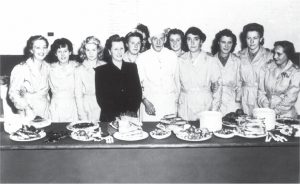
Staff of the American Red Cross canteen which was run from the back room of airfield building 223.
The Women’s Voluntary Service (WVS), begun in 1938, proved to be of vital importance on the Home Front. The WVS badge was as familiar as the ARP badge. Within the 1939 National Register there are two women already recorded as WVS members as well as three women ARP wardens. There was also a Red Cross Commandant and a Voluntary Aid Detachment (VAD) worker listed. Mostly, those Tadley women who had not been conscripted or volunteered put all their spare energies into working for the Women’s Institute.
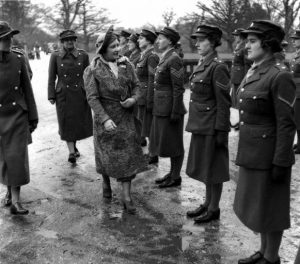
Her Majesty the Queen inspects a unit of the Auxiliary Territorial Service (ATS), of which she was Commander-in-Chief, at Aldermaston Court on 2 April 1941. The ATS was the women’s branch of the British Army during World War II. It was formed on 9 September 1938, initially as a women’s voluntary service, and existed until 1 February 1949, when it was merged into the Women’s Royal Army Corps.
Women’s Institute
The first Tadley branch of the Women’s Institute (WI ) was formed in 1918 just three years after the first ever British meeting was held in Anglesey, Wales. It was suspended after six years but reopened in 1933 and remained active until its final closure in 1982.
Because of its reluctance to support anything related to war work the WI directed its energies to looking after evacuees, knitting for the Armed Forces, raising funds for local organisations and running the Government sponsored ‘Preservation Centres’.
The Tadley WI voted overwhelmingly in August 1940 to become involved in this scheme and duly elected a committee and working party. Lowe’s Corner (now The Broomsquire Hotel) was designated as the communal Preservation Centre. Equipment was loaned by members. Produce brought to a centre by the grower was purchased and special permits allowed the purchase of sugar.
In October 1942, the WI reported in the Hants & Berks Gazette that the Preservation Centre had made 1,155 lbs of jam and 357 lbs of pickles and chutney, presumably in that season.
The reports of the branch meetings appeared regularly in the Hants & Berks Gazette and it is easy to build up a picture of the activities and lives of Tadley members. They met monthly in various Tadley homes where the host provided refreshments, which were often described as ‘sumptuous’! Funds for the purchase of wool were raised by running whist drives and raffles. Only eight months into the war and already 294 knitted articles had been sent to the front. By the same means money was raised for good causes at home. In August 1941 the Tadley WI raised £10 12s 6d for a new cot at Queen Charlotte’s Maternity Hospital. It was to be named the ‘WI Cot’. In September 1942 they sent £5 3s 2d to the Great Ormond Street Hospital appeal. These are just two examples among many.

